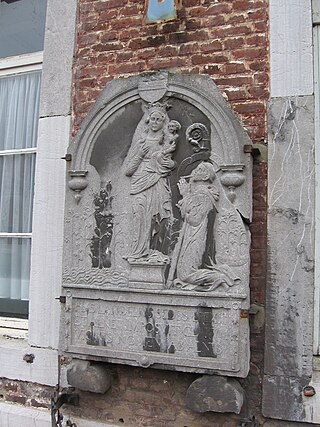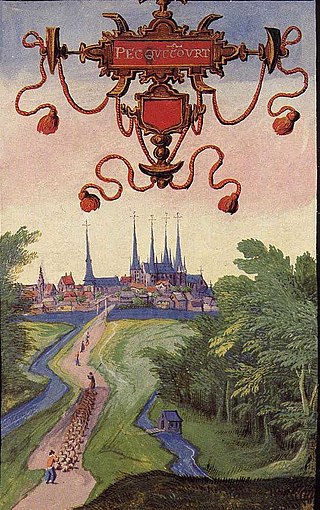
Crespin Abbey (French : Abbaye de Crespin) was a Benedictine monastery in the commune of Crespin in the department of Nord, France, founded around 648 by the reformed brigand Landelin of Crespin, also the first abbot, and dissolved in 1802.

Crespin Abbey (French : Abbaye de Crespin) was a Benedictine monastery in the commune of Crespin in the department of Nord, France, founded around 648 by the reformed brigand Landelin of Crespin, also the first abbot, and dissolved in 1802.
Landelin was born of a noble family, but became the leader of a band of brigands. [1] After his conversion to Christianity he became active as a missionary in the north of France. The traditional story is that he then withdrew with two disciples into the forest of the County of Hainault between Valenciennes and Mons, where he built a wooden cell on the bank of the Haine, which flows into the Scheldt at Condé-sur-l'Escaut. The owner of the forest took their clothes in compensation for the branches they had sawn off without his permission, and was struck lame: only when he returned the clothes did Landelin heal him. It is also said that after praying Landelin struck the ground with his staff, whereupon a strong spring appeared, the curling waves of which (Latin : crispantibus undis) caused him to name the spot "Crispinium" (Crespin). The reputation of the three hermits and the stories of these miracles attracted increasing numbers of disciples, for whom Landelin had a chapel built, which became the centre of the Benedictine abbey, dedicated to Saint Peter. Landelin was its first abbot. [2] He died there, probably in 686, and was buried in the abbey church.
From Crespin, Landelin founded Aulne Abbey on the banks of the Sambre in 656. [3] He is also credited with founding Lobbes Abbey in about 650, and the priory at Wallers-Trélon (now Wallers-en-Fagne) in 657.
The monastery flourished at first, because of its reputation for miracles at the intercession of Landelin, but in the 9th century found itself in increasing danger of being plundered or destroyed by the marauding Vikings. Landelin's relics were therefore moved, apparently in 836, to Boke in Delbrück near Paderborn. [note 1] In 870 the abbey was indeed destroyed by the Vikings. Although it was quickly rebuilt, it was not immediately re-dedicated as a monastery, but housed a community of secular priests, and was not re-occupied by the Benedictines until 1080. In 1095 Sigard of Chocques donated a mill and some land near Angre to the Abbey for the soul of William the Conqueror. [4]
From 1080 to 1802, when the abbey was dissolved in the Napoleonic period, there were altogether 48 abbots of Crespin. After its dissolution the abbey was sold off and destroyed.
Of the abbey church, first built in 673, only a few ruins remain. Of the other structures on the site only the abbot's house still stands, with a few ancillary buildings.

Thuin is a city and municipality of Wallonia located in the province of Hainaut, Belgium.

The Archdiocese of Cambrai is a Latin Church ecclesiastical jurisdiction or archdiocese of the Catholic Church in France, comprising the arrondissements of Avesnes-sur-Helpe, Cambrai, Douai, and Valenciennes within the département of Nord, in the region of Nord-Pas-de-Calais. The current archbishop is Vincent Dollmann, appointed in August 2018. Since 2008 the archdiocese has been a suffragan of the Archdiocese of Lille.

Fleury Abbey (Floriacum) in Saint-Benoît-sur-Loire, Loiret, France, founded in about 640, is one of the most celebrated Benedictine monasteries of Western Europe, and possesses the relics of St. Benedict of Nursia. Its site on the banks of the Loire has always made it easily accessible from Orléans, a center of culture unbroken since Roman times. In 2010, the abbey had over forty monks led by the abbot Etienne Ricaud.

Aulne Abbey was a Cistercian monastery located between Thuin and Landelies on the river Sambre in the Bishopric of Liège, Belgium. It is now a Walloon Heritage Site.

Ligugé Abbey, formally called the Abbey of St. Martin of Ligugé, is a French Benedictine monastery in the Commune of Ligugé, located in the Department of Vienne. Dating to the 4th century, it is the site of one of the earliest monastic foundations in France. The original abbey having been destroyed during the French Revolution, the current monastic community dates from 1853, and belongs to the Solesmes Congregation.

Gembloux Abbey was a Benedictine abbey near Gembloux in the province of Namur, Wallonia, Belgium. Since 1860, its buildings host the University of Liège's Gembloux Agro-Bio Tech faculty and campus.

The Abbey of Saint Victor, Paris, also known as Royal Abbey and School of Saint Victor, was an abbey near Paris, France. Its origins are connected to the decision of William of Champeaux, the Archdeacon of Paris, to retire to a small hermitage near Paris in 1108. He took on the life, vocation and observances of the Canons Regular, and his new community followed the Augustinian Rule.

Micy Abbey or the Abbey of Saint-Mesmin, Micy, sometimes referred to as Micy, was a Benedictine abbey near Orléans at the confluence of the Loire and the Loiret, located on the territory of the present commune of Saint-Pryvé-Saint-Mesmin. Since 1939 it has hosted a community of Carmelites.

Cistercian nuns are female members of the Cistercian Order, a religious order belonging to the Roman Catholic branch of the Catholic Church.
Lobbes Abbey was a Benedictine monastery in the municipality of Lobbes, Hainaut, Belgium. The abbey played an important role in the religious, political and religious life of the Prince-Bishopric of Liège, especially around the year 1000. The abbey's founding saint is Saint Landelin; four other saints are also connected with the abbey.

Saint Landelin is a saint in the Eastern Orthodox Church and Roman Catholic Church.

The Abbey of Saint-Germain d'Auxerre is a former Benedictine monastery in central France, dedicated to its founder Saint Germain of Auxerre, the bishop of Auxerre, who died in 448. It was founded on the site of an oratory built by Germanus in honor of Saint Maurice.
The Congregation of St. Vanne or Congregation of St. Vanne and St. Hydulphe (French: Congrégation de Saint-Vanne et Saint-Hydulphe was a Benedictine reform movement centered in the Duchy of Lorraine. It was formally established in 1604 on the initiative of Didier de La Cour, prior of the Abbey of Saint-Vanne near Verdun, a reformer of the Benedictine Order after the Council of Trent. The Abbey of St. Hydulphe at Moyenmoutier was a secondary centre of the reform.

Anchin Abbey was a Benedictine monastery founded in 1079 in the commune of Pecquencourt in what is now the Nord department of France.

Saint Ermin of Lobbes was the second abbot of Lobbes Abbey.
Aimery I of Narbonne, son of Bernard Berenger of Narbonne and Foy of Rouergue. He was viscount of Narbonne 1071 until his death in the Holy Land in 1106.
Préaux Abbey was a Benedictine monastery dedicated to Saint Peter at Les Préaux, in Normandy, France.

The Abbey of Saint-Seine is a former Benedictine monastery located in Saint-Seine-l'Abbaye, Côte-d'Or, Burgundy, France. During the Middle Ages it was a wealthy and powerful institution. It was suppressed at the French Revolution.

Saint-Maur Abbey, originally called the Abbaye des Fossés, is a former abbey now subsumed in the Saint-Maur-des-Fossés suburb of Paris, France. The remains and the domain of the abbey have been transformed into a pleasure park named Parc de l'abbaye. The former abbey building has been replaced by a square at the corner of Avenue de Condé and Rue de l'Abbaye. Some ruins remain, such as the Rabelais tower, the 19th century Bourières villa and the old fortifications. The remains of the abbey have been classified as historical monuments since June 13, 1988.

Beaugerais Abbey is a former Cistercian abbey, located in what is now the commune of Loché-sur-Indrois, in the Indre-et-Loire département of France.